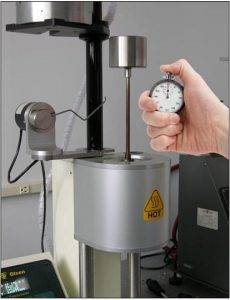Though often criticized, MFR is a very good gauge of the relative average molecular weight of the polymer. Since molecular weight (MW) is the driving force behind performance in polymers, it turns out to be a very useful number.
Melt indexers, or extrusion plastometers, are common lab tools used to determine the melt flow rate (MFR). The test, while often disparaged, gauges the relative average molecular weight (MW) of the polymer. Since MW is the driving force behind performance in polymers, it turns out to be a very useful number.
People from all parts of the industry downplay the value of the test or denigrate its usefulness outright. Those who instruct industry professionals on processing are quick to point out that the melt flow rate (MFR) value for a material is a single point on a curve that characterizes viscosity as a function of shear rate. Since plastics are non-Newtonian, their viscosity varies with shear rate.
The melt flow rate test moves the molten material at a single flow rate, therefore a single shear rate, and fails to capture the full range of the behavior of a material as a function of changing shear rate. To make matters worse, the shear rate is not even controlled. While the load on the material, or the shear stress, is constant during the course of the test, the shear rate is an output of the test. The MFR itself is a reflection of the shear rate used during the course of the test, but it is a result of the test and not a controlled input.
In fact, melt flow rate testing is a poor tool for gauging processability, for some reasons But it was never intended to be a measurement of processability; this is an interpretation that has been applied by some in the processing community. The notion that a melt flow rate tester is some type of poor man’s capillary rheometer is fundamentally incorrect. In addition, the relationship between MFR and average molecular weight is a relative one. There are a lot of factors that can skew this relationship and make interpretation tricky.

For example, adding ingredients to a compound such as glass fibers, impact modifiers, and certain additives can alter the MFR of a material without changing the average molecular weight of the polymer one bit.
But if the test is so useless, why does the value appear on so many material data sheets? Not only is it a line item on the majority of published data sheets, it is often the key characteristic that distinguishes one grade of material from another within a given polymer family. In materials as diverse as polycarbonate, acetal, and polystyrene, the MFR may be the only value on the data sheet that varies significantly from grade to grade within a particular product offering.
The reason is simple. Assuming that all other factors are kept constant, the MFR is a very good gauge of the relative average molecular weight of the polymer. Since molecular weight (MW) is the driving force behind performance in polymers, it turns out to be a very useful number.
Flow rate in a polymer is related inversely to viscosity. High-viscosity materials flow with greater resistance and therefore more slowly under any particular set of conditions than low-viscosity materials do. Therefore, higher-MW polymers have lower MFR values and lower-MW polymers have higher MFR.
Practitioners of injection molding prefer the latter because it is easier to fill demanding flow paths in a mold with what is referred to as “high-flow” materials. Extruders and blow molders are more likely to prefer higher-MW materials because they provide higher melt strength, a factor that makes it easier to control the shape of a parison or a complex profile, die-swell considerations notwithstanding. End users prefer higher-MW polymers whether they know it or not, because higher MW correlates with better product performance. Impact resistance, fatigue performance, environmental stress-crack resistance (ESCR), and barrier properties (to name a few) all improve with higher MW.





